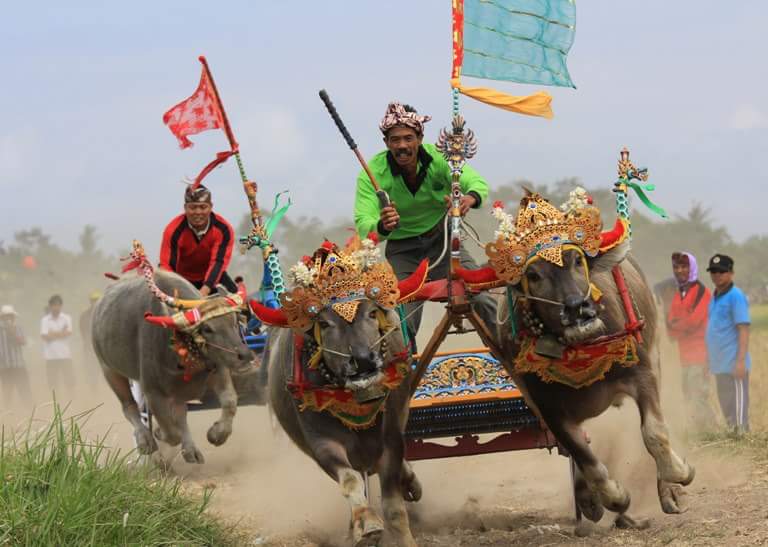
Makepung (Indonesia, Bali)
- Name of sport (game): Makepung
- Name in native language: Makepung
- Place of practice (continent, state, nation):
The Makepung races are held every two weeks throughout the dry season, always on Sunday. There are seven different circuits that are used for the races and they’re all located in Jembrana, West Bali.
- History:
Before the race became popular in the 1930s, it took place on wet fields to facilitate the working of agricultural land. Now it takes place on dry land.
Makepung is the name of a major grand prix in Jembrana, West Bali, which features racing buffalo races. Hundreds of pairs of buffaloes are teamed up together with their jockeys. They ride the traditional wooden ploughs that are slightly modified for the competition. The racer buffaloes, or kerbau pepadu, compete in various open race circuits in assorted heats. These series of competitions are held around the district of Melaya. They lead up to the finals, known as the Jembrana Regent’s Cup and the Governor’s Cup.
West Bali’s Jembrana region entertains its residents and visitors in the know with its Makepung, a water buffalo race introduced about a century ago by migrants from neighbouring Madura. Wearing colourful banners and crowns, their horns decorated and wooden bells tied around their neck, the bulls race down an erratic track. It’s remarkable to see such docile creatures thunder across the finish line at a speed. The daredevil charioteers often ride standing up on their chariots, twisting the bulls’ tails to give them extra motivation. Farmers and their buffalos come to race for honour, pride and the trophy, rather than for money.
Often spotted during Makepung (especially during the big competitions), is the region’s unique Gamelan Jegog, a musical ensemble using only bamboo instruments, some of which are gigantic 3-metre long tubes. Jegog music is very fast, rhythmic, and precise. The instruments are played in specific sequences and produce some wonderful sounds, while also being visually attractive. Some have likened the resonant sounds to roaring thunder as the music can be heard from quite a distance away. Gamelan Jegog accompanies traditional dances such as the Tari Silat (self-defence dance) and newer ones such as Tari Makepung (bull race dance). - Description:
Before the race, the buffalo’s horns are painted and they are adorned with colorful ribbons and harnesses. A pair of two water buffaloes is paired with a jockey and hooked up to a traditional wooden plough. Teams are divided into east and west, which you can recognize by their uniforms. Teams from the east wear red while those from the west wear green.
The race track is made up of 125 m of wet rice field with four pairs of buffalo compete in one round. It becomes more fun when the jockey falls and wallows on the muddy land during the traditional race. - Current status:
Practiced
- Sources of information :
Film - https://www.youtube.com/watch?v=wkVQx5vPKAA
Film - https://www.youtube.com/watch?v=xe8vFbGYl9g
Film - https://www.youtube.com/watch?v=YXQDLXvDbQ4 - Gallery:

